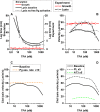Co-ordinated spatial propagation of blood plasma clotting and fibrinolytic fronts
- PMID: 28686711
- PMCID: PMC5501595
- DOI: 10.1371/journal.pone.0180668
Co-ordinated spatial propagation of blood plasma clotting and fibrinolytic fronts
Abstract
Fibrinolysis is a cascade of proteolytic reactions occurring in blood and soft tissues, which functions to disintegrate fibrin clots when they are no more needed. In order to elucidate its regulation in space and time, fibrinolysis was investigated using an in vitro reaction-diffusion experimental model of blood clot formation and dissolution. Clotting was activated by a surface with immobilized tissue factor in a thin layer of recalcified blood plasma supplemented with tissue plasminogen activator (TPA), urokinase plasminogen activator or streptokinase. Formation and dissolution of fibrin clot was monitored by videomicroscopy. Computer systems biology model of clot formation and lysis was developed for data analysis and experimental planning. Fibrin clot front propagated in space from tissue factor, followed by a front of clot dissolution propagating from the same source. Velocity of lysis front propagation linearly depended on the velocity clotting front propagation (correlation r2 = 0.91). Computer model revealed that fibrin formation was indeed the rate-limiting step in the fibrinolysis front propagation. The phenomenon of two fronts which switched the state of blood plasma from liquid to solid and then back to liquid did not depend on the fibrinolysis activator. Interestingly, TPA at high concentrations began to increase lysis onset time and to decrease lysis propagation velocity, presumably due to plasminogen depletion. Spatially non-uniform lysis occurred simultaneously with clot formation and detached the clot from the procoagulant surface. These patterns of spatial fibrinolysis provide insights into its regulation and might explain clinical phenomena associated with thrombolytic therapy.
Conflict of interest statement
Figures







References
-
- Longstaff C, Kolev K. Basic mechanisms and regulation of fibrinolysis. J Thromb Haemost 2015. June;13 Suppl 1:S98–105. - PubMed
-
- Shibeko AM, Panteleev MA. Untangling the complexity of blood coagulation network: use of computational modelling in pharmacology and diagnostics. Brief Bioinform 2016. May;17(3):429–39. doi: 10.1093/bib/bbv040 - DOI - PubMed
-
- Panteleev MA, Balandina AN, Lipets EN, Ovanesov MV, Ataullakhanov FI. Task-oriented modular decomposition of biological networks: trigger mechanism in blood coagulation. Biophys J 2010. May 19;98(9):1751–61. doi: 10.1016/j.bpj.2010.01.027 - DOI - PMC - PubMed
-
- Collen D. On the regulation and control of fibrinolysis. Edward Kowalski Memorial Lecture. Thromb Haemost 1980. June 18;43(2):77–89. - PubMed
-
- Wiman B, Boman L, Collen D. On the kinetics of the reaction between human antiplasmin and a low-molecular-weight form of plasmin. Eur J Biochem 1978. June 1;87(1):143–6. - PubMed
MeSH terms
Substances
LinkOut - more resources
Full Text Sources
Other Literature Sources
Miscellaneous

